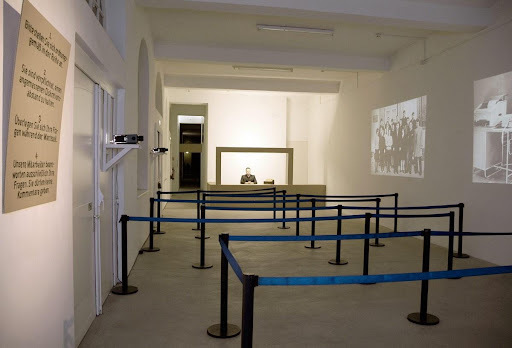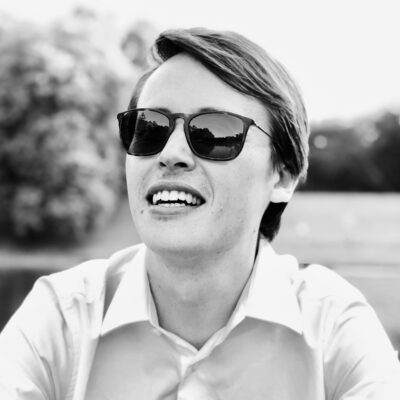Zomerblog: Colourful Black Boxes - Art in the age of AI
29.08.2023
Artistic lenses can be very useful and can embrace potential for change, empowering individuals in the face of technological development. Jonas Breuer introduces the Data Art Guide (DAG) , that will help audiences to find a way through the multifaceted sphere of A.I. and data-related artworks, and to make it more accessible for a broader public, DAG should become a public resource to explore and utilise how artists use many kinds of mediums addressing implications of technology and data usage on society.
In 2005, artist researcher Francis Hunger first presented his installation “The Setun Conspiracy”. In the installation, two slide projections showed a model of the Setun Computer, developed in 1958 by Ukrainian scientist Nikolai Brusentsov and his team. Other than most computer systems of past and present, which are based on binary logic, the Setun Computer was based on ternary logic. While the binary logic allows two states (yes (1) | no (0)), tertiary logic has three logical states: yes (1) | no (-1) | both or maybe (0).
By addressing the fundamentally different logic of computing that is underlying the Setun Computer, the artist purposefully triggers us to question something that we take for granted: the binary logic of our computers, an infrastructure as basic and essential as digital cement.

“The Setun Conspiracy'' (including the artist himself behind a desk), provided the visitor with well-researched information about the Setun Computer and its fundamentally different logic. Visitors were encouraged to ask questions. But they were also required to follow a set of specific rules. If they did not, they were to be emitted from the room.
The rules, the limited interaction with an authority behind his cold office desk (which, it turns out on closer inspection, is a feeble structure of plywood and paper), the setup of the room and the highly controlled flows of information create an atmosphere of high security places where human behaviour gets directed and information is so controlled that one may wonder what is true and what is make-believe.

https://www.irmielin.org/the-setun-conspiracy
Considering the production and representation of knowledge in an abstract artistic fashion, the installation plays with the idea of black boxes, creating an almost mythical sphere between certain knowledge and assumptions based on limited information, as well as our agency in such a controlled context of asymmetric power relationships.
Colourful Blackboxes
“The Setun Conspiracy” installation, by means of a historical artefact, demonstrates how art and creative expressions can have an impact on public awareness. Not only to provide information about historical, socio-technological developments in more engaging ways. Also, to question where information may come from and how it was generated. Within the hyper-accelerated technologically-driven society all around us, these aspects seem as significant as they are difficult.
Creative expression can provide effective triggers for public debate, open new ways of understanding and creating in relation to the technologies which are, indeed, revolutionary not least in the ways they enable creation. As Lauren McCarthy of p5.js pointed out, the immense evolution and complexity of today’s technological systems also entail exciting potential.
Perhaps we can think of colourful black boxes: complicated technologies that are complex enough to be open for tinkering and creativity.
After all, by using new technologies in surprising or even prescient ways artists have often been frontrunners of novel concepts, methods, and cultural practices. Artistic ideas, prototypes, artworks, and campaigns can offer new perspectives on intersections between technology and society. With different mediums and technologies, artists can challenge power structures, and envision alternative futures, allowing for a re-imagination of our relationship with technology.
What “The Setun Conspiracy '' points at is that looking at topics dominated by academic, corporate, and political elites through the art lens can be a step towards creating public awareness and opening the conversations about digital technology, and our identity and agency in that context.
Art in the Age of A.I.
Artificial intelligence is certainly a colourful blackbox.
It underlies advanced search engines (e.g., Google Search), recommendation systems (e.g. as used by YouTube, Amazon, and Netflix), understanding human speech (e.g. Siri and Alexa), self-driving cars as well as efficient generative tools (e.g. ChatGPT). Stories of hit songs by an A.I., of poetry written, paintings created, or a super cool coat designed for the pope not by humans but by machines may seem as dystopian as forward-looking for humanity.

To find a way through the multifaceted sphere of A.I. and data-related artworks, and to make it more accessible for a broader audience, we are developing the Data Art Guide (DAG). DAG should become a public resource to explore and utilise how artists use many kinds of mediums addressing implications of technology and data usage on society. By now, it includes up to 200 events centred around privacy, AI, surveillance, machine learning, IoT, data protection, apps, coding, hacking, and many more, presented through various artistic mediums. These include digital art exhibitions, book clubs, performing arts showcases, workshops, immersive experiences utilising VR headsets, webpages as playgrounds for storytelling, and numerous other avenues.
In Copenhagen’s SPACE10 Gallery, for example, Design in the Age of AI wonders how artificial intelligence changes the way we imagine, design, and build the world around us. The exhibition explores the role of generative A.I. tools as collaborators in an “era of democratic design where anyone can envision the products, places, and spaces of tomorrow”, visualising better ways to live and revealing new ideas. Or Fashion X AI, showcasing diverse AI empowered design solutions that push boundaries in the fields of fashion design, couture, ergonomics and textiles.
Exhibitions such as Imagine: A journey into the New Virtuality present an overview of the diverse design strategies of the "New Virtuality" and brings together exciting, partly newly produced projects by international architects, designers and artists, which in different ways deal with the challenges and potential of virtual space and the associated social, ecological, political and infrastructural effects. In Sabrina Ratt’s FUTURS SPÉCULAIRES, potential futures materialise to question the relationship between technology and the environment, the boundary between the real and the virtual.

Hacked Humanity
With the apparent enthusiasm about the value and force of A.I. enabled technologies, and the seemingly unstoppable technological evolution (bringing the Neo-Heiddegerian notion to mind that as we have a hammer, everything tends to become a nail) also very justified worries and voices of caution are being heard. And, as Mathew Hutson argued in The New Yorker in May 2023, the potential of artificial intelligence still goes much further than what we know today. Computer systems that can write code can improve themselves incrementally until they reach “‘the singularity’: a point at which it escapes our control.”2 ChatGPT, for example, has that ability.
Popular philosopher historian Yuval Noah Harari is not the only one who gained some attention this year with a doomsday scenario that artificial intelligence has hacked the operating system of humanity.
The Economist (28.04.2023)
With the ever-improving capabilities of machines, ethical considerations surrounding artificial intelligence in its different forms, and the desire of understanding its complexity become ever more urgent. Artistic practices and creative projects could have ever more potential to disseminate information and knowledge, to stimulate public awareness and debate in critical, creative and interesting ways. As the exhibition Perfect Behaviors. Life redesigned by the algorithm illustrates: there are alternative narratives to the dominant concept of technological determinism, to help make visible what is invisible, even when it is up close. It challenges the idea of artificial intelligence as a powerful autonomous creature inside opaque black boxes, emphasising instead how, behind the tools for measuring interactions, there is always a human being.
Overall, in recent years festivals have become a platform to showcase interesting artworks or educational materials that focus on these themes. For instance, the Transmediale Festival in Berlin, the glass room exhibition in various European cities, the Uroboros Festival in Prague, You and AI in Athens or the FIBER Festival in Amsterdam feature ground-breaking and experimental displays with a focus on reviewing the relationship between humans and technology in an ever-changing world.
Also Privacytopia, a new European art festival that revolves around datafication and the multifaceted impacts it has on society and humans, is operating on the intersection of so many visions: not only artistic ones, but also activist, educational and academic. Defending or criticising the visions and possibilities, confronting them, wondering if they will clash and if so, which ones will stand their guard? Privacytopia will be an artistic playground that loves to experiment, not least for and with youth and young adults, who are more susceptible for the potential of artificial intelligence as well as more impacted by its effects.
However, as nice as all that may be, it must be emphasised that art of course cannot be the solution to all or even any of the challenges on its own.
Artistic lenses can be very useful and can embrace potential for change, empowering individuals in the face of technological development. It can also make complexity more understandable and help criticise what is often presented to us as the inevitable evolution of humanity: we have the hammer, but not everything has to become a nail… However, educational activities in various ways are required before and in parallel to equip people with the necessary knowledge and critical thinking skills for navigating in the complex landscapes of colourful black boxes.
The Data Detox Kit by Tacticaltech, under your internet, the RoFT Experiment or the work and tools done by Mediawijs in Belgium among many others are examples of interactive educational materials that can work hand in hand with artistic work around the topics.
